
GLENN LONEY'S SHOW NOTES
Festival Futures: Salzburg and the Ruhr
By Glenn Loney, August 20, 2001

| |
|
Caricature of Glenn Loney by Sam Norkin. |
|
Open War on Pretty Productions
Dawn of the Ruzicka Era
Desperate Need for the New in Salzburg
Mortier's New Ruhr Triennale
Is Mozart Out of Date?
New Shows in Dis-Used Old Factories
Classical Record Companies Return to Salzburg Festival
Friends & More Friends of Salzburg Festival
Salzburg Scold Thomas Bernhard's Life & Works on Show
Unveiling the Herbert von Karajan Statue
New Modern Art Museum on Mönchsberg—But No Guggenheim
You can use your browser's "find" function to skip to articles on any of these topics instead of scrolling down. Click the "FIND" button or drop down the "EDIT" menu and choose "FIND."
How to contact Glenn Loney: Please email invitations and personal correspondences to Mr. Loney via Editor, New York Theatre Wire. Do not send faxes regarding such matters to The Everett Collection, which is only responsible for making Loney's INFOTOGRAPHY photo-images available for commercial and editorial uses.
How to purchase rights to photos by Glenn Loney: For editorial and commercial uses of the Glenn Loney INFOTOGRAPHY/ArtsArchive of international photo-images, contact THE EVERETT COLLECTION, 104 West 27th Street, NYC 10010. Phone: 212-255-8610/FAX: 212-255-8612.
For a selection of Glenn Loney's previous columns, click here.
SALZBURG FESTIVAL REPORT II:
Changing Chiefs at the Salzburg Festival!
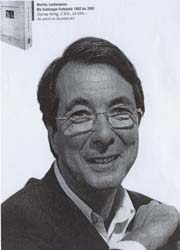 |
|
GERARD
MORTIER/AUTHOR & INTENDANT--His new book on his decade as Director
of the Salzburg Festival is published as he leaves this post for the
new Ruhr Triennale. Photo: Courtesy of Profil /Wien/2001.
|
After recent seasons of acerbic political & artistic controversy, Salzburg officials are keeping their fingers crossed, hoping they have made a good choice.
Much of the controversy was provoked by the "pugnacious" Mortier himself. And by his programing and choices of artists. The pugnacious epithet was recently invoked in the New York Times by music critic Bernard Holland.
The new Festival Intendant obviously cannot recreate what some Salzburg Old-Timers regard as the Von Karajan Glory Years. Nor would any talented, ambitious Artistic Director wish to do so.
Not only can you "not step twice in the same river," but—as Times & Tastes change—any arts-manager worth his salt wants to make his own mark, leave his own legacy.
There is no question of returning to the lavish opera productions of yesteryear, as no festival can afford such luxuries anymore. Nor are younger audiences interested in seeing powerful operas and resonant theatre-classics revived as Historical Costume Spectacles.
Producing musical or dramatic classics "under glass"—as though they were impressive [but safely dead] museum-exhibits—has always tended to distance them and their often potent social-comment from wealthy, self-satisfied audiences.
From those smug spectators who do not want to have a Night at the Opera spoiled by Social Consciousness. Keep Reality and Protest as far away as possible…
It was frequently charged by younger detractors of the late Herbert von Karajan—when the Salzburg Festival was His Personal Oyster—that his often glittering productions achieved exactly that distancing.
This is not really fair, as anyone who has followed festival productions over the years can testify. Some very powerful visual & emotional statements were made in a number of splendid productions.
But it is true that productions of the standard repertory War-Horses tended to be excessively handsome and often very decorative.
This made it easier for the bored Mercedes Board Member to ignore the rumbling social undertones of Figaro or Elektra. Not to mention ignoring their sexual politics as well…
The late Jean-Pierre Ponnelle—a favorite director/designer in the Von Karajan Era—was once one of Salzburg's most promising & innovative newcomers. He was introduced to me as such when he created his first Salzburg Figaro, with the late Hermann Prey.
I got to know him well over the years, and I must say that—no matter how stunningly handsome his sets & costumes were—his stagings and character-directions were always deeply thought-out, both in terms of the music and the emotional & social implications of the libretti.
There will always be "Canary-Fanciers" who ask nothing more of a new opera production than that the voices be admirable and the stage-pictures attractive. When those demands have been met, they park their brains—if any—for the rest of the evening.
Even though the actor-singers may be offering something very powerful, even seditious, on stage.
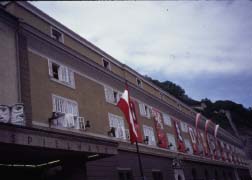 |
| FESTIVAL FLAGS--Grosses
Festspielhaus in Salzburg. Photo: ©Glenn Loney 2000. |
Open War on Pretty Productions!
Gerard Mortier declared War on Pretty Productions. But he sometimes erred in the opposite direction, by engaging directors & designers who were militantly opposed to anything attractive. And who were also, unfortunately, unable to help either the classics or new works make coherent social, emotional, or intellectual statements on stage.Updating sets, costumes, and social-behavior from antiquity—or the 18th century—to modern milieus and manners does not necessarily make Mozart, Verdi, Wagner, or Strauss more "relevant" or comprehensible.
In fact, to make a concerted effort to do this, in effect is patronising the audience: "You poor dumbos are obviously too ignorant or unsophisticated to understand what's at stake in Figaro, Fidelio, or Falstaff. So we'll make them accessible to you by updating them to Spanish Harlem!"
At one time in Manhattan, this could have been called "The Joe Papp Syndrome."
To make Shakespeare "relevant" for New York teens, a memorable New York Shakespeare Festival Papp production of Macbeth alternated speeches in English with lines in Spanish. This made at least half the play incomprehensible to non-Hispanics.
Fortunately, most of the high-school teen-agers were asleep at the performance I saw, so there was no real problem. As this staging was directed by Estelle Parsons, it was almost totally Greek to me…
Mortier has just presented "The Scottish Play" in the Hallein Salt-Mine drying-hall. It doesn't mix English & German, but it tries desperately hard to be Trendy & Relevant. Joe Papp would have loved it! Also Joe Mellillo of BAM…
If the classics of drama are still at all worth performing, it is not only their appeal over the centuries to something Universal in human feelings, aspirations, and fears. But it's also the power implicit in their characters, thoughts, and actions. These are not ordinary people, and—even in good translations—they don't think or talk like Just Plain Folks.
The same may be said of opera classics—but the music raises the universals and the specifics to much higher levels.
And, as singing the passions, longings, and dreads gives them even more power—and is of course a form of stylization—it is almost visually pointless to costume and stage the protagonists as though they were in some contemporary TV Soap-Opera or Sit-Com.
This is only yet another form of patronising the audience. It assumes that most modern audiences—especially younger ones—could not possibly understand, identify with, or care about frustrated lovers of five hundred years ago.
The undiminished popularity of Romeo & Juliet—even in period sets & costumes, performed for school audiences—certainly gives this idea the lie.
In fact, updating & modernising older works for fear modern spectators won't be interested in them, suggests that producers & directors who do this think their audiences are really stupid. And also incapable of empathy with people who are—at least superficially—not like themselves.
Producing Antony & Cleopatra with the Romans as Serbs and the vanquished Egyptians as Bosnian Muslims may seem a cute, trendy, updated vision of this drama of All for Love, Or the World Well Lost. Fortunately, not even Mortier's directors have tried that one yet
Some Mortier antagonists have accused him of having a "Tin Ear." They may be confusing his musical acuity with his sometimes bizarre visual sense.
A collegue phrases it this way: "Gerard doesn't have a tin ear at all. He has a very good ear for music, musicians, and performance. What he may have instead is a tin eye."
On the day that Mortier held a press-conference to announce his new Ruhr-Triennale festival, an obviously irritated Salzburger unloaded his dissatisfaction with Mortier's work in the press by noting that, as Mortier was paid with governmental tax-monies, he was "the best-paid Foreign-Laborer [Fremdarbeiter] Austria has ever had."
And yet, the writer concluded: "He openly attacked his employer, the Republic of Austria." This appeared in the Salzburger Nachrichten, so few could have missed it.
Signed by Senator [hc] Dr. Georg Berger Sandhofer, the letter dismissed Mortier with: "Bye, bye! Bon Voyage!"
Dawn of the Ruzicka Era
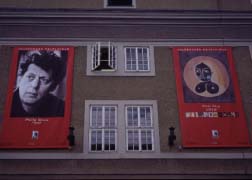 |
| MORTIER'S POST-MODERNISM--Salzburg
Festival Banners for Phillip Glass and Alban Berg's "Lulu."
Photo: ©Glenn Loney 2000. |
And soloists and other artists are already contracted. So it will take a while before the nature and shape of the Ruzicka Intendancy at the Salzburg Festival can be measured.
His credentials, however, are very impressive. Not only was he Intendant of the prestigious Hamburg Opera from 1988 to 1997, but his production-program there won the theatre the distinction of "Opera-House of the Year" in 1996/97.
He has been Intendant of the Berlin Radio Symphony, artistic advisor to Amsterdam's Concertgebouw Orchestra, and successor to Hans Werner Henze as Leader of the Munich Biennale for New Music-Theatre.
Dr. Ruzika also succeed the late Prof. Dr. August Everding as President of the Bavarian Theatre Academy.
But he is not primarily an opera-theatre manager, though he obviously does that very well.
He is an important modern composer, whose works have been widely played by major orchestras. He has also conducted a number of distinguished orchestral ensembles.
The fact that he studied Law, Economics, and Musik-Wissenschaft—before he began studying composition seriously—suggests that Salzburg's Peter Ruzicka is a many-sided, multi-talented artist & manager.
As such, he should be able to build his own distinctive legacy on the solid foundations of those created by Herbert von Karajan and Gerard Mortier.
The Desperate Need for the NEW in Salzburg:
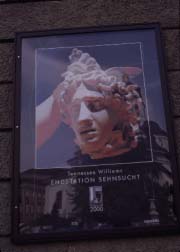 |
|
TENNESSEE
WILLIAMS & MEDUSA--Poster for trendy Salzburg production of "Streetcar
Named Desire." Photo: ©Glenn Loney 2000.
|
Under Mortier's management, Mozart & Strauss—former Household Gods—found it difficult to compete with more modern composers. Although they did finally emerge with Modern Honors, thanks to some astonishing innovations in the perception & presentation of their works.
John Rockwell's summer Lobgesang in the New York Times for Gerard Mortier and his stewardship of the Salzburg Festival reads more like a calculated endorsement by a Culture Editor seeking new employment as an Arts Manager.
But one should not forget that Rockwell was, in fact, briefly manager of the then fairly unimaginative Lincoln Center Festival. It was said that, had the Times not been so eager to have his services as Culture Editor, he wouold have been forced out of that position anyway.
Uneasy Lies the Head That Wears an Arts Manager's Crown!
This summer, however, the front desk in the Salzburg Festival press-office was, generously strewn with Xerox copies of Rockwell's Mortier Festschrift!
So his Summing Up of the Era Mortier is apparently acceptable—even gratifying—to the departing Intendant.
When Mortier first appeared upon the Salzburg scene, he was most charming to the press, public, and the politicians—of whom the Kultur-Politiker can be the most difficult and even dangerous to artists and arts-managers.
But he made it clear that he intended to champion New Music, New Music-Theatre, and New Theatre in general. And in innovative, provocative productions—which had been the hallmark of his tenure as Intendant at Brussels' Théâtre Royal de la Monnaie. His Ruth Berghaus-directed productions there are still avidly discussed.
In Salzburg, he immediately began innovating with a vengeance that horrified—and alienated—the Stein-reich Old Guard. Some of whom decided to fight back—by staying away from the annual festival. This is seldom a winning strategy…
In his unrelenting search for the New, Mortier has engaged some counter-culture directors and designers who have wreaked visual and structural havoc on some venerable works of theatre.
Peter Sellars, a Mortier pet, has done this on several occasions, notably with Ligeti's Grand Macabre, for which Sellars even inserted his own libretto in the program, for he was staging a different work than that devised and composed by Ligeti.
Nor was Messiaen's St. François d'Assise—in Sellars' bizarre staging—quite the wonder John Rockwell suggests when he notes its "near-universal acclaim."
Dawn Upshaw & José van Damm were remarkable, but nearly incapacitated by the tiny high raked-stage Sellar's favorite designer devised for them.
When the voices are glorious, the orchestra in sonorous synch, and the set-pieces stupendous—if virtually unplayable—then most Music Critics are in a Diminished-Seventh Heaven.
Not so with Theatre Critics—especially those watching to see how productions really work. If indeed they do…
Actually, Mortier had some of the most stunning & innovative avant-garde theatre & opera productions without the dubious inventions of Peter Sellars or the trance-like stagings of Robert Wilson.
These were created by Luc Bondy and Peter Stein, both of whom Mortier managed to drive away from the festival.
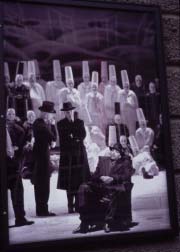 |
| ] BUSONI'S "DOKTOR FAUST"--Premiered at the Salzburg Festival/Moved to the Metropolitan Opera. Photo: ©Glenn Loney 2000. |
Gerard Mortier's Next Mountain To Climb—
The New RUHR TRIENNALE:
New Works in Old Workplaces!
When this year's Salzburg Festival is over, Gerard Mortier will take a six-months' sabbatical before beginning intensive work on programing the new Ruhr Triennale, a festival of new works in disused industrial structures in Germany's Ruhr District.The name suggests this fest will occur only every three years. But Mortier assured auditors at a recent press-conference in the painting-hall of Salzburg's Kleines Festspielhaus that something will be produced every year, with an emphasis on the second.
This new festival won't be like any of the major ones now established. Nor will it compete with the major Central European Festivals.
Mortier intends that no performances will be offered in July or August, when Bayreuth, Bregenz, Munich, and Salzburg are in full swing.
Instead, the festival periods will be divided: May-June and September-October. The early summer sections of the Triennale will focus on theatre; the fall sections on music.
First off the drawing-boards and into the rusty industrial monuments will be the Autumn 2002 music fest.
Considering the fact that German federal, state, and city arts-subsidies have been steadily diminishing since Die Wende—or the Fall of the Berlin Wall & German Re-unification—major theatres in such Ruhr cities as Essen, Dortmund, Düsseldorf, Bochum, Oberhausen, Wuppertal, Gelsenkirchen, Duisberg, and Cologne have had to cut back on programs and ensembles.
All these cities—after the devastation of World War II bombings—acquired handsome new, or wonderfully renovated, theatres. Some even have separate drama-theatres and opera-houses. Most also have studio-theatres.
But the day of Drei-Spalt theatres—playing different productions of opera, dance, and drama every night, seven nights a week, even in smaller cities—is coming to an end.
In America, of course, it's almost inconceivable that one theatre could or should present operas, operettas, musicals, dramas, ballets, and modern dance in rotating repertory.
Not to mention being able to sustain the performing ensembles and the requisite orchestras and dance-troupes.
At present, some theatres produce only drama or opera. Some co-produce, touring to two or three neighboring cities, sharing productions. Some of the great modern Ruhr District theatres of the Post-War Era are now dark on some nights.
The famous Black-Box City-Theatre in Gelsenkirchen was one of the most admired & innovative theatre-spaces in that era. But even it is not playing every night.
The fact that Mortier and the new festival are currently headquartered in Gelsenkirchen could possibly be an added irritation to its city-theatre. But Mortier and his colleagues in the project are quick to point out that it in no way duplicates or supplants what the area's theatres have been or are now doing.
Nor are its governmental subsidies taking anything away from conventional theatre subsidies.
In fact, Michael Vesper, Culture-Minister for the German State of North-Rhine-Westphalia, emphasised at the press-conference the preceding months of negotiations with various municipal authorities to ensure a basic budget which in no way affects other arts projects.
Some idea of budgeting-sources may be gleaned from the fact that Vesper's Ministry is responsible for city buildings, housing, culture, and sports. North-Rhine-Westphalia is the major sponsor, with support from the various cities of the Ruhrgebiet, and the Pro-Ruhrgebiet association.
The 2002 budget is 16 Million DM—the sum will be in Euros, by that date—with additional income from ticket-sales and corporate sponsors. Because the Triennale is scheduled to peak in its second year, it will receive 42 million DM for 2003.
But this is just the first round of Triennales, if all goes well.
Nonetheless, there are about 7 million potential spectators in the Ruhr. If Mortier and his team can create the new performance projects and forms they envision, there may well be something for everyone in festival season.
Mortier notes the tremendous popularity of football and the existence of a huge new stadium. Just how football and its athletic-supporters can be integrated into an innovative performance remains to be seen. But this is an immense—largely male—audience Mortier and Vesper do not want to neglect. Or to alienate.
The centrality of Pop Culture—especially in the lives of young people—also needs to be recognised. But not pandered to: Not esoteric Modern Dance going Hip-Hop just to attract audiences.
Mortier stresses that he dislikes the term "Crossover"—usually invoked when a waning opera-star makes a CD of songs from Broadway Musicals.
He prefers the idea of "integration" with other forms of performance and artistic expression, as well as with community cultures and aspirations.
Is Mozart Out of Date?
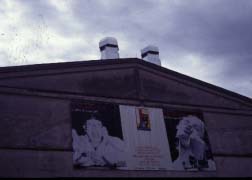 |
|
SALT-MINES
SHAKESPEARE & GOETHE--Banners for Desconstructionist "Schlachten"
& "Faust" on Hallein Salt-Hall. Photo: ©Glenn Loney
2000
|
He apparently respects the music, but dislikes the libretti—whether by Da Ponte or Schickaneder. He wants to find new ways in producing the operas—even in narratives, scenic-environments, & in action—for modern audiences to "connect" with this remarkable music.
At the press-conference, he insisted that modern spectators are not interested in the romantic problems of Count Almaviva, Suzanna, the Countess, and Figaro.
But he does believe very much in the Power of Sentiment.
So do not be surprised if Peter Sellars is asked to rework his trio of TV Mozart productions, with the Commendatore being buried in an open sewer-trench in front of a broken-down tenement in Manhattan's Spanish Harlem.
Or perhaps the music and the outline of Da Ponte's story can be "integrated" into the lives of Duisbergers and into the shards of what was once a great German Steel Factory?
Perhaps with "Pedro" Almaviva now a Spanish Fremdarbeiter—taking advantage of new European Union freedoms of travel and work—trying to set up an auto-repair-shop and Bodega in an old steel-mill?
And when Cherubino—a cross-dressing young Goth—crashes down from the factory-crane onto the gardner's plants, Almaviva will be extremely angry because the kid has just ruined the marijuana crop?
In this hopelessly egocentric, rudderless era, with the disappearance of the most basic courtesies and consideration for others—not to mention Air Traffic Safety—it may very well be that Mortier is right.
Mortier may be on target about modern audiences. That they not only are not interested the the social codes and moral values of other eras.
But that they are also so clueless and ignorant that they couldn't possibly understand what's really involved in the marital & pre-marital hi-jinx on the Almaviva Estate.
If this is actually the case, then there is little to be hoped for in future.
And the avant-gardist performing arts won't either aid or console baffled, frightened audiences. For they will be busy reflecting, endorsing, or introducing the latest Socio-Cultural Excesses.
Social Disintegration will accelerate—as in the Balkans, the Middle East, Northern Ireland, and East, Central, & West Africa—and it will have been pointless to have tried to learn anything from either History or the Cultures it has generated.
And, as Mozart's graceful, stylized theatre-music is so much a part—not only of his own time—but also of the operas and plays for which it was composed, it may seem entirely at odds with modern up-dated free-for-alls and Così fan tutte as Mud-Wrestling on stage.
 |
| ] MILLS OF THE GODS?--Powerful Mill-Wheel for Janácek's "Jenufa," staged summer 2001. Photo: ©Bernd Uhlig 2001. |
Performing Arts & The Factory Factor:
Because all Gerard Mortier's Ruhr Triennale performances will be given in older industrial structures—now abandoned or eroding, as the coal and steel industries have atrophied—no established theatres will have to yield their stages to the new works.In fact, they will be encouraged to mount repertory productions which relate to the special stagings.
Mortier plans to have Peter Sellars rework the Messiaen St. François he staged at Salzburg in the pre-industrial Felsenreitschule. He suggests Pelléas et Mélisande might be a very good complementary production to mount at a neighboring city-theatre.
He is especially eager to give new life to Bernd Alois Zimmermann's innovative opera, Die Soldaten, based on the classic German novel, Lenz.
In its initial productions, notably in Munich, at the Bavarian Statte Opera, it astounded audiences. It even made a deep impression on New York City Opera audiences.
But it is no longer in any major repertories. Not even in Zimmermann's native Cologne. So Mortier thinks this Soldaten project would be a good fit for the city of 4711 Cologne.
Paul Claudel's Souliers de Satin is also on his wish-list. And he hopes to have works developed by Peter Brook and Frank Baumbauer, Theatre Chief at the Salzburg Festival and new Intendant of Munich's Kammerspiele.
Because the new Triennale productions will be developed in site-specif historic structures—none of which was ever intended to be a theatre—they won't be adaptable to regular repertories, removing another potential threat to established Ruhr theatres. Though there will be co-productions with other festivals & venues, to share costs and artists.
I asked Mortier about potential co-productions with American avant-garde venues. He noted that there are certainly possibilities in New York. I suggested BAM sponsoring a production from, say, Essen, reworked for the Brooklyn Navy Yard.
Both Michael Vesper and Mortier stress that the challenge for the artists will be: "…in these one-of-a-kind historic Spaces, Halls, and Places of Industry-Culture, to leave worn-out paths and create a new repertory."
The Salzburg Festival's recent Magic Flute—staged by Achim Freyer in the city's glass-&-steel Messe-Halle—was an initial Mortier attempt to explore the possibilities of Industrial Architecture as performance-spaces.
It was a big success, encouraging parents to bring their kids, and the public to relax in casual dress. Instead of the tuxes and evening-gowns which are the Standard Salzburg Festival Uniforms.
Among the Triennale's selected spaces—some of them Landmarked, or, as the Germans say, Unter Denkmal Schütz—are Bochum's Century Hall, Duisberg's Central Power-House, and even Oberhausen's towering Gasometer, in which Christo recently stacked a lot of colored oil-drums. Well, you can't be Wrapping the Reichstag every year, can you?
The Gasometer is scheduled to house an arts-installation involving 5 projection-screens 18 meters high.
It will be a needed touristic/economic shot-in-the-arm for Duisberg if Mortier's artists can create a Power-House Production in the disused power-station of the abandoned Thyssen Steel Factory.
The stinking soft-coal—heavy with sulfides—from the Ruhr's mines is no longer in demand. And steel and other industrial products can now be made much more cheaply in other lands.
The heavy clouds of smoke & soot which once hung over the Ruhr—and which could turn your white shirt brown in a few hours, especially on a train trip—are long gone. But so is a lot of employment.
Gloom—instead of smoke—now hovers over Ruhrgebiet cities.
The Triennale's new productions will be in no sense conventional, and they will draw on all forms of performing arts, as well as graphic and spatial arts.
Pina Bausch—who made the Ruhr District city of Wuppertal world-famous with her touring avant-garde choreographies—will be overseeing dance aspects of the festival.
Austria' own most innovative & inimitable composer/performer, Klaus Michael Grüber, is composing his first opera for the festival.
For those who want to know more about the Triennale—especially performing artists or others who believe they may have what it takes to create an opera in a gas-works—the mailing-address is: KULTUR RUHR GmbH, Leithstrasse 35, D-45885 Gelsenkirchen, Germany. Phone: +49-709-167-1700. FAX: +49-709-167-1710.
Or try the Internet: info@kultureruhr.com
Come Back, Come Back, Recording Companies!
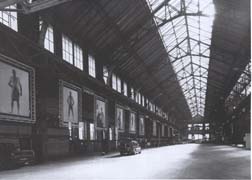 |
|
WAITING
FOR RUHR TRIENNALE--Dis-Used Monument of the Industrial Revolution to
be New Mortier Performance Venue. Photo: ©LEG Düsseldorf 2001.
|
All Is Forgiven! But Who Is Buying the Classics?
In Herbert von Karajan's time, virtually every shop-window in Salzburg featured glamorous photos of conductors, opera & concert stars, and famed instrumental soloists. These were provided—in very high-quality displays—by major recording companies.They traditionally maintained attractive Press-Centers at the Festival, with champagne receptions for favored artists and the obligatory Photo-Ops and interviews.
It was not lost on reporters & reviewers that the artists represented by Teldec, DGG, EMI, RCA, HMV, and Philips were also featured in the Festival in major ways.
In addition to a press-luncheon—sitting by conductor Kent Nagano in Mozart's Birthhouse—there might be a brunch with Anne Sophie Mutter, or a snack with Catherine Malfitano. Plus a complementary copy of the new video of her Tosca, featuring a leap from the top of Castel San'Angelo—filmed in the actual locations in Rome.
Mortier regarded all this commercial interaction with the Festival—and with the press who had come to cover the Festival—as somewhat incestuous.
And even potentially harmful to the freedom of the Festival Director to contract the artists he desired, with no pressure from recording companies, eager to issue a new, definitive Salzburg Festival CD.
But as news in the Press-Office of their summer locations & programs was curtailed or eliminated, so also was the market for opera-videos and the eighth New & Complete Recording of Aida dying a slow, painful death.
Perhaps encouraged by Mortier's impending departure, three labels returned this summer, but only after the 15 August Feast of Maria Himmelfahrt—or the Ascent Into Heaven of Both the Incorruptible Body & Soul of the Virgin Mary.
The labels—with some interesting new CDs, including the Salzburg Easter Festival Bryn Terfel Falstaff—were Decca, Philips, and Deutsche Grammophon. But all three are now under the same corporate umbrella, appropriately named Universal Classics.
EMI was in its usual comfortable office on the second floor of a medieval courtyard in the heart of the Old City.
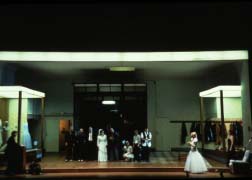 |
| MOZART FOR MODERNS--Gerard Mortier encourages Updating "Marriage of Figaro" for summer 2001Salzburg Festival. Photo: ©Ruth Walz 2001 |
Friends, Friends, and More Friends!
In these tough times of plummeting stock-markets, rocketing unemployment, and vanishing state-subsidies, summer festivals need all the support they can get.Not only does the Salzburg Festival enjoy the patronage of Alberto Vilar—to the sweet tune of more than eight-million-dollars to date. But it also has the Usual Suspect Corporate Sponsors,
And not one, but two, organizations of Friends. The Freunde der Salzburger Festspiele even have an Online-Publikation: Salzburger Festspiele-Dialoge. These interviews range from 1994 to 2001, featuring Mortier himself, Nike Wagner, Rolf Hochhuth, Rolf Liebermann. Peter Sellars, & Edward W. Said.
These can be accessed at: http://www.festspielfreunde.at
Not to be outdone, the American Friends of the Salzburg Festival—heavily endowed by Alberto Vilar & Richard Coburn—sponsor pregnant presentations every summer.
This season the New Yorker music-critic Paul Griffiths offered two lectures: one on Verdi & Shakespeare, "Making Falstaff Sing." The other on the problems Shostakovich had with Stalin, centered on his Lady Macbeth of Mtsensk.
There were also two interesting interview-conversations. One with Thomas Hampson—the Posa of Don Carlo—was devoted to "American Song and More." Baritone Hampson has been featured in several popular crossover CDs.
The other was a conversation with Sir Simon Rattle. Plus lectures by Karen Painter and Bryan Gilliam.
These well-attended events were free to all.
Not so with the handsome chambers on the second floor of the Grosses Fesstspielhaus, which are reserved for the American Friends, Once they were thronged with the formally dressed public, both European & American.
At that time, anyone with a valid opera ticket had acccess to these halls. And that is where I once greeted the former President of Austria—and ex-UN General Secretary—Kurt Waldheim.
I had been introduced to him six months previously on an official press-trip to Vienna. No one else approached him and his gracious wife, for reasons which are now part of history for some—and totally forgotten by most others.
Thomas Bernhard on Display
In Museum Carolino Augusteum
 |
|
MOZART
FAMILY PLOT--If Wolfgang Amadeus were in this Salzburg grave, he'd be
whirling over what Mortier has done to his masterpieces. Photo: ©Glenn
Loney 2000.
|
Even more compelling in Festival season for such an exhibition is the fact that Bernhard abandoned a fledgling career in journalism to study acting at the Salzburg Mozarteum.
This training led him to playwriting—for which he is better-known outside Austria than he is as a novelist and poet. Among his works which were premiered at the Salzburg Festival are Der Ignorant und der Wahnsinnige, Die Macht der Gewohnheit, Am Ziel, Der Theatermacher, and Ritter, Dene, und Voss.
Videos, set-models, costumes, production-photos, and text excerpts help revive memories of these productions—or introduce them to adults and students who have never seen them anywhere.
Because some of Bernhard's later satiric dramas were so hilariously savage in their attacks on various aspects of Austrian Pride, Tradition, Politics, Culture, and general Meanness of Spirit—and were thus denounced by critics and politicians—he finally forbade production of his plays in Austria.
Famously confrontational, he was taken to court by a priest who believed Bernhard had libeled him in one of his semi-autobiographical novels. He subsequently removed the offending passages from that book.
These legal difficulties—and his treatment at the hands critics—are thoroughly documented in this exhibition, which is very handsomely designed. It is divided into various areas of his work and life.
Even though he was closely bound to Salzburg, it was clearly a Hate-Love relationship. He once denounced the Mozart-Stadt as a Dead City, mired in Catholicism.
Unfortunately, Bernhard as playwright and novelist is better known in the United States by reputation, rather than by reading and viewing.
But it may be—as with Germany's Ödön von Horváth—that it's now time for a series of dynamic stagings of Bernhard's dramas.
There is also a well-illstrated and very informative catalogue of the exhibition. But of course in German. The show will close the end of October.
More information on Bernhard, the catalogue, and the show may be obtained from email: office@smca.at There's also a website: http://www.smca.at
 |
| SALZBURG'S SOUR PLAYWRIGHT--Satirist Thomas Bernhard in the Coffee-House. Photo: ©Johannes Barth 2001. |
Unveiling the Herbert von Karajan Statue—
As I was zooming-in on the new statue of Salzburg's Favorite Son—after Mozart, of course—I was accosted by roving interviewers from the local ORF TV station. What did I think of Herbert von Karajan's Legacy in Salzburg? Would it endure?But what, in fact, was this Legacy?
Is it the Festival Documentation Series of the Maestro conducting great singers and the Vienna Philharmonic in memorable Salzburg productions on CDs? Is it the videos of his often grandiose stagings of the great War Horses of Opera?
Or is it even more intangible? The international fame which he brought to Salzburg and its Festival after the devastations of World War II?
Whatever his legacy in programming & production may have been, the outgoing Festival Director, Gerard Mortier, has striven to replace it with newer works, newer stagings, and even newer audiences. And Alternative Everything…
Some of the wealthy & elite Old Guard of Von Karajan Admirers have turned their attention to the new Baden-Baden Festival. But this seems doomed for lack of a sufficiently cultivated public or even adequate tourism.
The previous day—before I was suddenly on-camera—I had been present at the formal unveiling of Anna Chromy's life-like bronze statue of the Maestro.
Responding to the TV interviewers, I hardly knew what to say. I can speak simple German well enough—when not under stress. But I confused the term for unveiling—Enthüllung—with that for exhuming or excavating—Ausgrabung. So I hope they didn't broadcast it…
Herbert von Karajan's handsome widow, Frau Professor Dr. Eliette von Karajan, helped unveil the statue, flanked by various local political & cultural celebrities.
Gerard Mortier was conspicuous in his absence. Actually he was elsewhere, engaged in autographing his book about the Salzburg Festival, in a Signier-Stunde.
Festival President Dr. Helga Rabl-Stadler—whom Mortier had frequently attacked in the press, in his tendentious campaign for a more modern, more open, more affordable Festival—took this opportunity to point out that just because some things are "old" doesn't mean they are necessarily bad or outworn.
And that not everything New is necessarily good.
She didn't offer specific instances, but the conservative friends and politicians around her certainly understood her meaning.
Although Von Karajan is now most often identified with the Berlin Philharmonic—owing to Kultur-Politics in Vienna, which forced him to make some changes in his power-bases—the Salzburg Festival again gave him the Vienna Philharmonic every summer. So an ensemble from the Wiener Philharmoniker played for the unveiling.
The lovely & stylish Ms. Chromy noted that she'd portrayed the Master as he looked in his fifth decade, at the height of his career. She said she had never met him, but in creating the sculpture, she had come to "know" him.
I once sought an interview with him in Salzburg, but he'd just had some heart problems. His very protective secretary suggested that, should he consent to the interview, that would take his precious limited energy away from the Festival.
What would I prefer? My interview with the Great Man? Or more concerts and opera-productions which everyone could enjoy?
Well, when you put it that way…
I saw him conduct his last concert in Carnegie Hall with the Berlin Philharmonic. He was shrunken and bent, holding onto the podium for support.
He was obviously in great pain, but fiercely determined to give New Yorkers one last Great Moment. Even if he died in doing it, which fortunately he did not.
For Mortier's supporters, however, this very belated Act of Recognition & Honor for Von Karajan must seem rather like a last-ditch attempt to reinstate the Master's Legacy with the departure of Mortier and the accession of the new Festival Director, Peter Ruzicka.
As he is known as a Modern Composer, there seems no turning back. Nor should there be.
[But then, isn't everyone who composes now a modern composer By Definition? Unless, of course, they are infatuated with Mozart Pastiches like John Corrigliano?]
The handsome Von Karajan statue now stands in a locked garden facing the River Salzach and its amazing new curved footbridge.
The figure is backed by the Neo-Classic facade of Von Karajan's Birthplace, Hummelstrasse No. 1—across the street from Hotel Sacher Salzburg, formerly the Österreichischer Hof Hotel.
The family must have been wealthy, as this is a very impressive Palais. Unfortnately, it was sold by the Master's brother, Wolfgang, and now is filled with commercial offices.
Time for the City & Land of Salzburg to reclaim it and make it into a Museum for the Master's Legacy and for the Festival itself!
The Von Karajan statue was funded by the Salzburg Foundation, which curiously uses that English word, instead of the German Stiftung. It is concerning itself with preserving & promoting Salzburg's Cultural Inheritance.
The magnificent Churches, Monasteries, and Palaces of Salzburg's Prince-Archbishops now seem in good repair. But the Foundation is planning to position sculptures by internationally known artists in various parts of the Altstadt.
Last summer, like Manhattan, Salzburg's Old City—just ike Manhattan—was over-run with Painted Cows.
This year, it is to get a sculpture from Anselm Kiefer. It won't look anything like that cow with Lederhosen & Backpack in front of the Cathedral last season, however.
No New Guggenheim in Salzburg's Mountain—
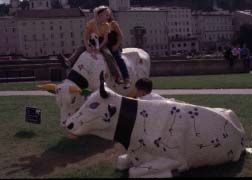 |
|
NOT
ONLY IN NEW YORK--Colorful Painted Cows in Salzburg. Photo: ©Glenn
Loney 2000.
|
But a Museum of Modern Art on Its Summit!
Salzburg is now proclaiming itself as the Museum-Stadt, as well as the internationally famed Mozart-Stadt.In addition to its many Museums, Galleries, Monuments, Landmarks, Plaques, Statues, & Birth-Houses, it will also now have a Museum of Modern Art!
For some time now, Thomas Krens, Director of New York's Guggenheim Museum, has been trying to convince Salzburgers they should have a local branch inside the great stone Mönchsberg, which towers with its medieval Festung above the Old City.
The success and acclaim of Frank Ghery's Bilbao Guggenheim—not to overlook the prestige of branch Guggenheims in Berlin & Venice—has not been lost on some local citizens who live from Mozart & Tourism.
But the great mountain has already had ancient buildings, the Felsenreitschule, and the Grosses Festspielhaus built into it, not to mention a vast parking-garage actually inside it.
Some feared weakening the stone-mass. But there is actually a lot of stone there, as the mountain is more like an extended ridge sheltering the Old Town.
At the moment, a Salzburg Guggenheim seems a Dead Issue.
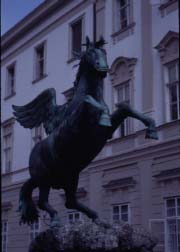 |
| PEGASUS LAUNCHING ALOFT--Not the new Herbert Von Karajan Statue, but earby in Mirabel Gardens. Photo: ©Glenn Loney 2000 |
But a new Salzburg Museum der Moderne will indeed now be built.
But atop the mountain, not inside it. And it won't be another Guggenheim Branch. At least not as currently planned.
During the Festival season, the model and architects' drawings were on display in the Rupertinum. This gallery of modern art is across from the Festival theatres but it's far too small for its already impressive collections. These are to occupy the ground floor of the new museum.
It will replace the historic Scenic Viewpoint & Casino, theCafé Winkler, but the mini-castle & tower—with its high-powered searchlight raking hotel-windows into the night—is to remain.
If the proposed museum actually gets built. Some Salzburg citizens now find the model and plans ugly, banal, and unimaginative. "Bad Bauhaus!" one artist told me.
This site is some distance along the Mönchsberg ridge from the great Festung, or fortified castle, which is accessed by a funicular railway and hiking-paths.
The new Salzburg Museum of Modern Art is to be reached—as the Winkler in the past—by the Mönchsberg elevator, with its shaft cut into the mountain's living stone.
The Munich architectural firm of Friedrich, Hoff, & Zwink won the design-competition with a fairly self-deprecating Bauhaus clone.
That the building fits into the landscape and does not call too much attention to itself in such historic surroundings is acceptable, if not exactly admirable. It is to provide restaurant facilities to replace those now in the Winkler.
The promo-brochure notes that visitors will be "transported by special elevators along a spiral-shaped route that passes through the various exhibition areas."
This sounds like one of those educational ride-throughs at the recent Hannover World's Fair, EXPO 2000.
Despite its MoMA name in translation, it is properly styled Museum der Moderne.
And there is no apparent connection—at present, at least—between MoMA and Salzburg. MoMA's Glenn Lowry may want to change that, for he is already developing exhibit-sharing projects with some foreign museums of Modern Art.
The new museum is to be opened in 2003.
But it is only part of an arts-upgrading program which also includes relocation of the historical collections of the Museum Carolino Augusteum to the Prince-Archbishops' great baroque Neues Residenz Palace.
As well as a renovation of the University's Mozarteum and the Salzburg Festival's Kleines Festspielhaus.
Not to overlook the funds needed for the Celtic Museum in nearby Hallein. The Celts weren't only in Ireland.
That costs a lot of money. Around 110 Million Euro is the current price-tag. The Euro will be the common European currency after l January 2002.
And Salzburg may not have heard the last of Thomas Krens and the Guggenheim either… Krens is very good at raising money!
In fact, several Salzburgers—with whom I discussed the museum-scene—suspect that there will still be a Guggenheim branch in Salzburg. But neither in nor on top of the Mönchsberg.
Stay tuned for future developments!
[Loney]
Copyright © Glenn Loney 2001. No re-publication or broadcast use without proper credit of authorship. Suggested credit line: "Glenn Loney, New York Theatre Wire." Reproduction rights please contact: jslaff@nytheatre-wire.com.
| museums | recordings | coupons | publications | classified |